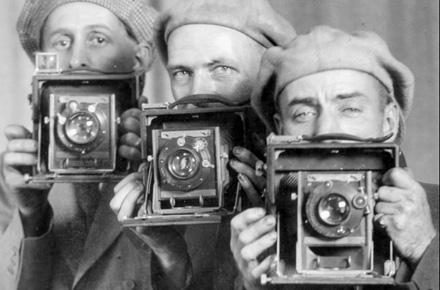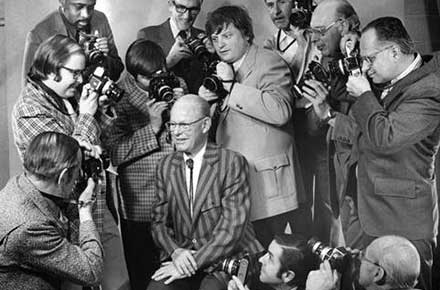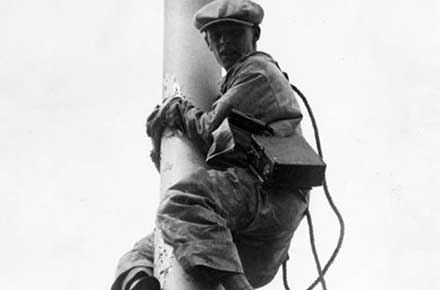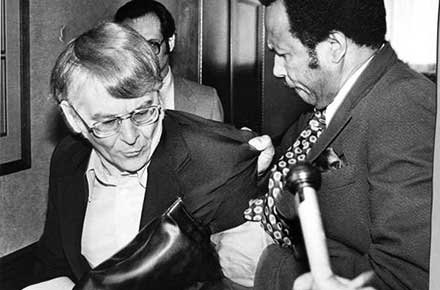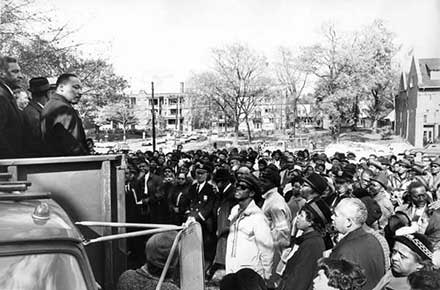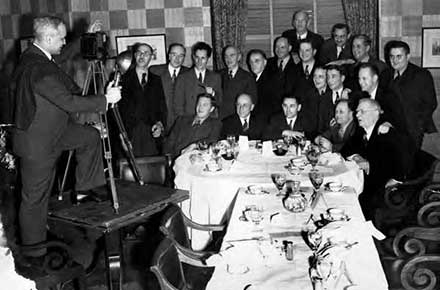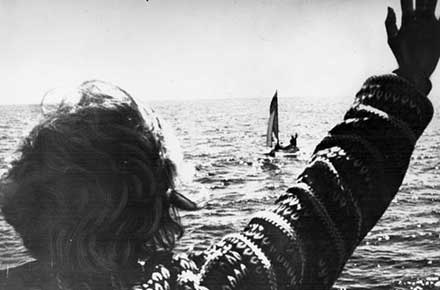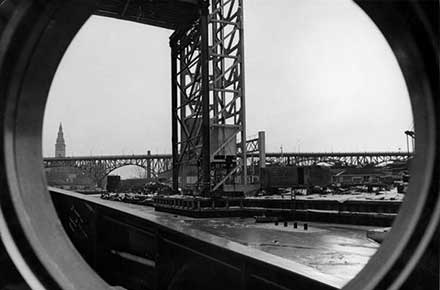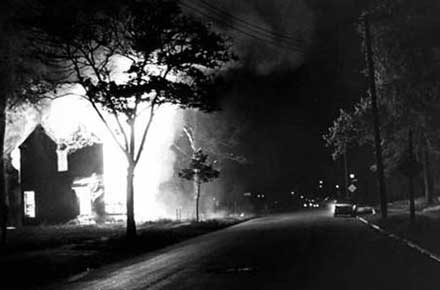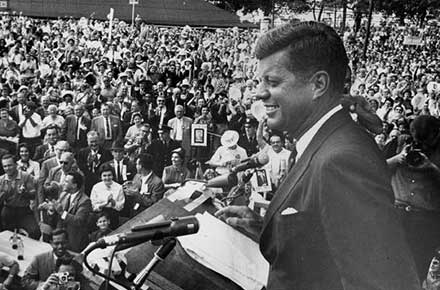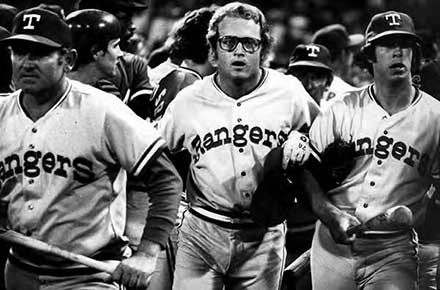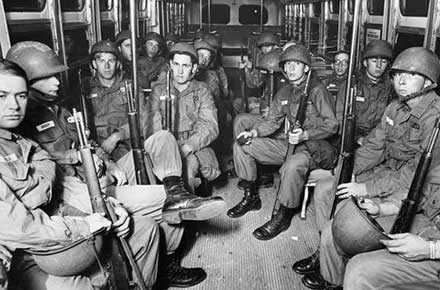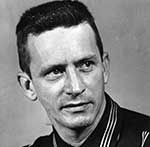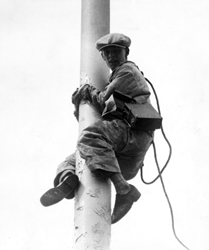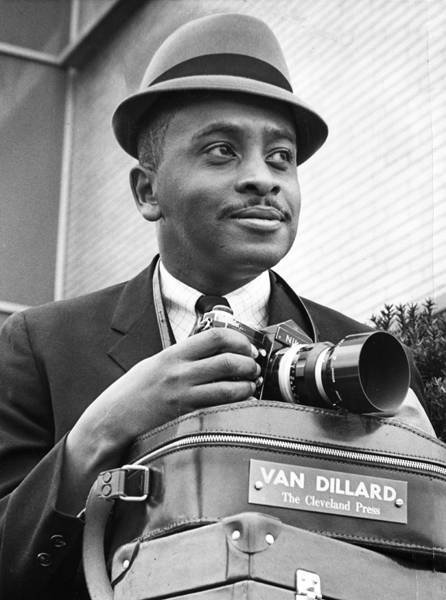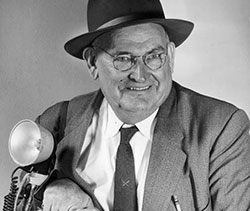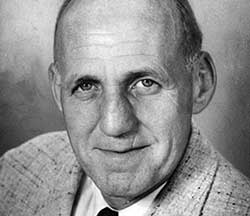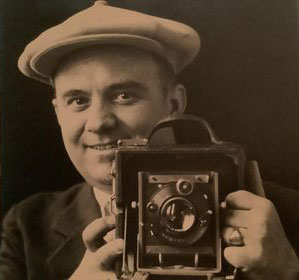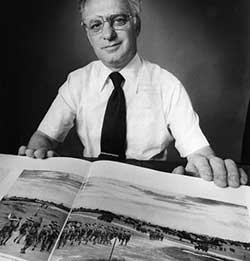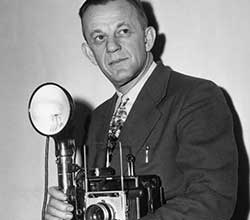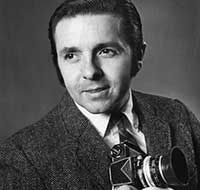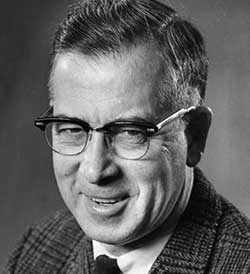Cleveland's Photojournalists
Cleveland, with its strong tradition in the newspaper business, has produced a long line of celebrated photojournalists who have used their images to tell the story of Cleveland and its citizens.
Here we attempt to return the favor, capturing bits of their own stories. We offer this page as a pathfinder to the tens of thousands of their photographs now preserved in the Cleveland Memory Project, and as a salute to these brave and adventurous journalists, who, as Cleveland Magazine once said, "illuminated the humanity behind The Cleveland Press".
Frank Aleksandrowicz (1922-2014), Cleveland Press
Frank Aleksandrowicz came to work as a news photographer at the Cleveland Press after his former employer, Erie Dispatch, folded. He served in the U.S. Army as a photojournalist during World War II and the Korean War. Particularly after the Cleveland Newspaper Strike of 1962, he focused his efforts on commercial photography. In addition to winning many awards for his photographs, Frank Aleksandrowicz was also nominated for a Pulitzer Prize.
William Ashbolt (1926-1999), Plain Dealer
William Ashbolt was an award-winning journalist who was a combat photographer for the U.S. Marines and photographer for the Plain Dealer until his retirement in 1988. Two significant events covered by Ashbolt's photograph collection are the investigation of Sam Shepherd in the murder of his wife, Marilyn Shepherd, and the Robert Manry's cross-Atlantic excursion in his sailboat, Tinkerbelle.
- William Ashbolt's Photography in Cleveland Memory
- Encoded Archival Description (EAD) finding aids for archival material about William Ashbolt in Ohio
Fred "Fearless Freddie" Bottomer (1904-1985), Cleveland Press
Fred Bottomer worked as the sports photographer for the Cleveland Press. Beginning with the Press in 1920 as an office boy, he transitioned to photographer and captured on film such events as the Lorain tornado of 1924 and the union strikes of the 1930s though he spent the majority of his career covering Cleveland sports. He was rightly nicknamed "Fearless Freddie" whether he was getting hit by errant foul balls, climbing the Terminal Tower pole, or hanging off a 1920's airplane wing for the perfect shot. Bottomer took a leave from the Press and served in the U.S. Navy as chief photographer in the Pacific Theater, remaining active in the Naval Reserve after the war. He was honored with numerous Newspaper Guild Awards including the Best Sports Photo of 1955.
Tim Culek (1947-2009), Cleveland Press
Tim Culek worked at the Cleveland Press as a news photographer. He was awarded the Best News photo by the Cleveland Newspaper Guild in 1977. He captured one of the more memorable images in Cleveland photojournalism as Roldo Bartimore was being removed from a city council meeting by council president George Forbes (displayed in photo gallery at the top of the page). After working as the photo assignment editor at the Press, Culek joined WEWS Channel 5 as the night assignment editor. He went on to work at Lake Erie College in Painesville, retiring in 2003. Mr. Culek died in Cleveland, April 20, 2009
- Tim Culek's photography in Cleveland Memory
- Obituary from the News-Herald
Van Dillard (1937-1998), Cleveland Press
Van Dillard majored in photojournalism at Kent State University, keeping his job at the post office as a safety net while working toward his degree. While still a student, he secured an internship at the Cleveland Press, eventually making history as Cleveland's first Black daily newspaper photographer when he was offered a permanent position 1967. Dillard, a role model to many, stayed at the Cleveland Press until it folded in 1982.
Eddie Dork (1894-1986), Cleveland News
Edward Dork, known to nearly everyone as "Eddie," worked as a photographer for the Cleveland News. He spent 50 years in the Cleveland newspaper business as a photographer beginning in November 1908 as an "office boy" for the Cleveland Leader. He then transitioned to Cleveland News where as a teenager he worked as a photographer's assistant until he worked his way up to photographer. Eddie served in World War I as a cook in the U.S. Army (he was not allowed to have a gun because of his German descent). Early in his career, Eddie made a name for himself as a photographer for the News by covering such historic events as the Lorain Tornado of 1924, the Cleveland Clinic disaster of 1929, the Ohio Penitentiary fire of 1933, and the East Ohio Gas explosion in 1944.
Byron "Shorty" Filkins (1890-1963), Cleveland Press
Byron Filkins worked for more than fifty years as a news photographer for such papers as Cleveland Sunday News-Leader, Chicago-American Examiner, Cleveland News, and for many years with Cleveland Press. He photographed all the presidents from Theodor Roosevelt to Dwight Eisenhower and all the Cleveland mayors from Tom Johnson to Anthony Celebrezze.

George Grant
Photo provided by George Grant.
George Grant, Cleveland Press
George Grant was a staff news photographer for the Cleveland Press from 1952 to 1959 and a winner of NewsGuild-CWA’s Heywood Broun Award honoring great journalism that exposes social injustice.
While working at the Press one of his photos, depicting a rapid transit train in a blinding snow storm, was featured in Life Magazine. Grant had flashed flash-bulbs at the driver of the onrushing train to warn of a utility pole blocking the rails, thus narrowly averting disaster.
After leaving the Press, Grant traveled extensively for Cleveland television station WEWS, covering both the Algerian and the Cuban revolutions, as well as accompanying President Eisenhower on a global trip. Grant later worked as a cameraman in Washington D.C, where he photographed all presidents from Eisenhower to Jerry Ford, filmed an Emmy-winning seven part television series on the workings of Congress, and was the White House Press Pool film cameraman for President Nixon’s resignation speech.
Jerry Horton (1915-1977), Cleveland News and Cleveland Press
Jerry Horton worked for Cleveland newspapers as a photojournalist for 35 years for both Cleveland News and Cleveland Press. He began as a copy boy with Cleveland News in 1931 and several short years later joined the photo dept. He took a leave from the News and served as the photographer for the U.S. Army Signal Corps during World War II. Jerry Horton was the most decorated combat photographer earning a Purple Heart, Silver Star, and three Bronze stars. As a spot news photographer, he was honored with two awards from the Cleveland Newspaper Guild and the Ohio Press Photographers Association awarded him the top award for his work of capturing a robbery in progress on film. When Cleveland News folded, he joined the Cleveland Press as news photographer.
Clayton Knipper (1910 - 1986), Cleveland Press
Clayton Knipper began as a copy boy with Cleveland News in 1931 and within six months transitioned to the News Photo Dept. He worked for the Cleveland Press as a photographer from 1939 until 1977 (serving as chief photographer 1970-1977). President Dwight Eisenhower sat for him privately and Knipper covered the Sam Shepherd trial from start to finish. Additionally, he was the first photojournalist to receive the Cleveland Newspaper Guild Award for reporting (coverage of the brutal slaying of Cynthia Pfell in Upper Sandusky).
James J. Meli (1894-1977), Cleveland Press
James Meli, who served in the Navy before the first world war was a freelance photographer whose first photo assignment was to cover the death of Warren G. Harding in 1923. During his long career at the Press, he photographed Amelia Earhart a month before her disappearance, and Babe Ruth at the height of his fame. His subjects also included Bob Hope, President Calvin Coolidge, Mary Pickford and George Raft. Meli died in Scottsdale Arizona, April 28, 1977.
John "Bud" Nash (1913-1960), Cleveland Press
John Nash began as a copy boy with the Cleveland Press in the early 1930's and quickly transitioned to news photographer. He took a leave from the Press to serve in World War II and was stationed in London as combat photographer for 8th Air Force. After the war, he returned to Cleveland Press where he earned a reputation as a spot news reporter until his untimely death in 1960.
Bill Nehez (1919-2009), Cleveland News and Cleveland Press
Bill Nehez worked as a photographer for Cleveland News before serving in the U.S. Army. In the Army, he served as combat photographer for the Signal Corps, covering the invasion of Normandy and other events in the European theater. After returning home, Bill Nehez worked as a photographer and journalist for Cleveland Press.
- Bill Nehez's photography in Cleveland Memory
- Encoded Archival Description (EAD) finding aids for archival material about Bill Nehez in Ohio
Larry Nighswander (1948-2014), Cleveland Press
Larry Nighswander began his career in photojournalism at an early age by working as a freelance photographer while still in college. He began as news photographer at the Cleveland Press the day after graduating college and worked for numerous other newspapers during his career including the Columbus Dispatch, Cincinnati Post, and Washington Times. Later in life he worked for the Bonnier Corp. where he served as the director of photography for a number of magazines and also as a college professor of photography and the Director of the School of Visual Communication at Ohio University. He won numerous awards including Scripps-Howard Designer of the Year (twice) and Magazine Picture Editor of the Year (1993) for his work in National Geographic.
Bernie Noble, Cleveland Press
For nearly four decades, Bernie Noble worked as a news photographer for the Cleveland Press beginning in 1945. He was honored with numerous awards by the Ohio News Photographers Association and Cleveland Newspaper Guild. His photograph of President Dwight Eisenhower was chosen to serve as the Eisenhower 6-cent stamp issued on October 14, 1969. In 1978 he was promoted as the Press' chief photographer.
Frank Reed (1915-1989), Cleveland Press
Frank Reed worked as a photographer for the Cleveland Press from 1956 until 1980. He enlisted in the U.S. Army where he received training in photography as served as combat photographer in the South Pacific in World War II. He famously was one of the photojournalists who photographed the surrender of the Japanese aboard the U.S.S. Missouri. After the war he worked for Cleveland News Pictures until 1956 when he joined the Press. As a photographer for the Press he primarily served as the "society photographer" covering fashion and Cleveland society news.
Herman Seid (1908-1980), Cleveland Press
Herman Seid joined Cleveland Press in 1924 as an office boy after graduating from high school and quickly transitioned to the photo dept. He was on the scene with his camera at such historic events as the Cleveland Clinic disaster in 1929 and Ohio Penitentiary fire in 1930. He served as a photographer for three years with the U.S. Army Signal Corps and Air Corps in the China-Burma-India Theater during World War II. Seid was honored with numerous awards from the Cleveland Newspaper Guild, Ohio News Photographers Association, May Show, and Time Magazine.
Paul Tepley (1931 - 2018), Cleveland Press
Paul Tepley was a sports photographer for Cleveland Press. After studying journalism for 18 months at Kent State University, he enlisted in the U.S. Navy where he served on Admiral's staff as photographer. After the Navy, Tepley worked as a photographer for United Press International before landing at the Press in 1962. Four years later, he was named the Press' sports photographer. Together with Tony Tomsic, Paul Tepley represented the next generation of sports photographers following Fred Bottomer. Tepley was honored with numerous awards by the Ohio News Photographers Association and in 2005 the Press Club of Cleveland inducted him into the Cleveland Journalism Hall of Fame.
- Paul Tepley's photography in Cleveland Memory
- Paul Tepley obituary from Cleveland.com/Plain Dealer
- Encoded Archival Description (EAD) finding aids for archival material about Paul Tepley in Ohio
James Thomas (1905-1967), Cleveland Press
James Thomas worked as a photographer for the Cleveland Press for more than 31 years. While working for the Harshaw Chemical Company, he decided to make his hobby of photography his new career. He worked for Cleveland Sunday News-Leader and Akron Times-Press before joining the Press as news photographer in the 1930's.
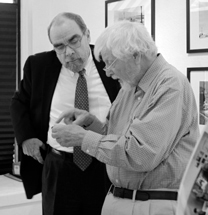
Tony Tomsic (right) in 2015.
Photo by Donna Stewart.
Tony Tomsic (1935-2019), Cleveland Press
Tony Tomsic joined the Cleveland Press in 1955 and succeeded Fred Bottomer as sports photographer. After spending 25 years at the Press, Tomsic worked as a freelance photographer for Sports Illustrated, ESPN, and the NFL. Known as the "Dean of the Super Bowl shooters," he covered every Super Bowl until 2015. When asked about a favorite photograph, he pointed to the Vince Lombardi being carried off the field after Super Bowl II. Tony Tomsic was inducted into the Cleveland Journalism Hall of Fame by the Press Club in 1994.
- Tony Tomsic's photography in Cleveland Memory
- Keepers of the Streak - A documentary by ESPN films that focuses on the four photographers who have attended and photographed the first forty-eight Super Bowl games from 1967-2014.
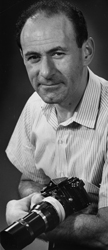
Paul Toppelstein in 1966.
Photo by Frank Reed.
Paul Toppelstein (1925-2022), Cleveland Press
Paul “Toppy” Toppelstein was the in-house studio photographer when the Press closed in 1982. His career started in World War II when, after a brief start in the Army and a 19-day trans-Atlantic voyage on the un-escorted SS Pasteur to England, he transferred to the Army Air Force’s 457nd Bomber Group. There he processed incoming film from the bomb runs over Germany, checking bombing patterns and doing other related duties. Discharged in 1945, his first professional photography job was with the Newspaper Enterprise Association, a Scripps-Howard company, where he worked for eleven years. When the Cleveland Press started its suburban section, he transferred there before becoming the studio photographer. All his photography skills were self-taught.
Louis Van Oeyen (1865-1946), Cleveland Press
Louis Van Oeyen was a pioneering figure in photojournalism, notably serving as the first staff photographer for the Cleveland Press. His breakthrough came in 1901 when his photographs of the Lake Erie water intake explosion disaster and the assassination of President William McKinley were published in the Press. Throughout his 40-year career with the newspaper, Van Oeyen captured portraiture, politics, disaster scenes, crime, scandals, and sports events. Baseball held a special place in his heart, leading him to become the official photographer for the American League in 1908 and for the World Series until 1922.
His contributions extended beyond photography as he actively participated in testing new photographic equipment, including the General Electric flash bulb in 1938. Revered as the "dean of Cleveland newspaper photographers," Van Oeyen left an enduring legacy in the world of photojournalism before retiring in 1937. He passed away in December 1946, but his impact on the field and his iconic images continue to be celebrated.
- Louis Van Oeyen's photography in Cleveland Memory
- Encoded Archival Description (EAD) finding aids for archival material about Louis Van Oeyen in Ohio
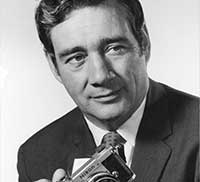
William Wynne (photo courtesy of
William A. Wynne).
William Wynne (1922-2021), Plain Dealer
William "Bill" Wynne was an award-winning photographer and photojournalist. He served as an aerial photographer and camera operator for the U.S. Air Force during World War II, conducting photo reconnaissance in the Southwest Pacific and Far East. After the war, William Wynne served as a photojournalist for the Plain Dealer in capturing the visual record of historically significant events in Cleveland politics and society. As an advocate for justice, Wynne was honored as part of the investigative journalism team that exposed the abuses at Lima State Hospital for the Criminally Insane in the 1970's.
- William Wynne's photography in Cleveland Memory
- "Shooting from the Heart", by William Wynne. Chapter 6 from Plain Dealing: Cleveland Journalists Tell Their Stories, by Dave Davis and Joan Mazzolini
- Encoded Archival Description (EAD) finding aids for archival material about William Wynne in Ohio
Glenn Zahn (1914 - 1970), Cleveland Press
Glenn Zahn started working with the Associated Press as an office boy early in the 1930's. After working for nine years with the AP and Cleveland News, he began working as photographer with Cleveland Press and was appointed chief photographer in 1952. He covered such events as the East Ohio Gas Co. explosion and 1952 Republican Convention in Chicago; he also is reputed to have taken the first photo of Dr. Sam Shepherd the day his wife was found murdered.
Other Cleveland Press Photographers Represented in Cleveland Memory
We have thousands of images captured by the following photographers, but no biographical info for them, or photos OF them. Can you help? Get in touch!

